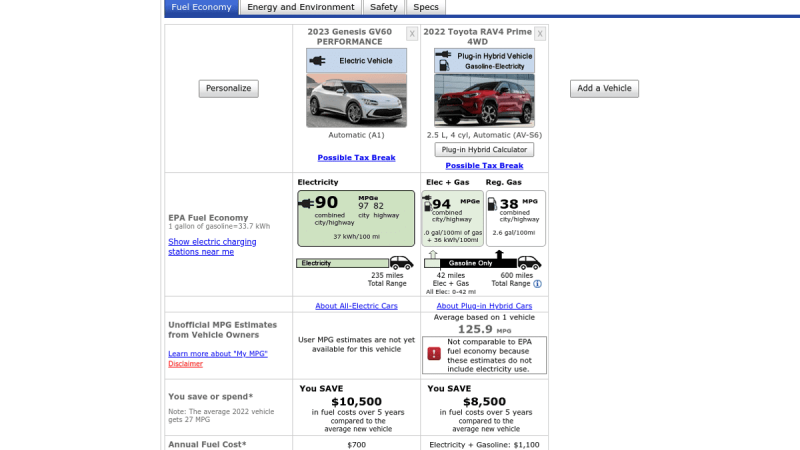Two of the very best all-wheel drive crossovers available this year are the all-new Genesis GV60 and Toyota RAV4 Prime. Each comes with a plug, and each has segment-leading acceleration. In fact, each is the quickest crossover each company makes. So how did the Toyota RAV4 Prime, which can burn gasoline in certain modes, end up being the one with the better EPA rating?
Related Story: 5 Plug-in Hybrid EV Myths Battery-Electric Purists Wish Were True
Weight is one reason. Because the Genesis GV60 is carrying around a massive high-voltage battery, its weight is nearly 5,000 pounds. Mass has a penalty when it comes to efficiency, and the Genesis GV60 Performance pays the price. The RAV4 Prime plug-in hybrid-electric vehicle (PHEV) by contrast, has a weight about 600 pounds lower. This despite it having both electric motors and a gas engine to “carry around.”
The EPA rating for electric vehicles is Miles Per Gallon Equivalent, MPGe. It’s an imperfect unit of measure, just like MPG is in conventional vehicles. The EPA uses it so that shoppers can compare various models to one another when they are looking for a new vehicle to buy. Higher indicates a higher efficiency and a lower cost of energy. So higher is better. The RAV4 Prime’s MPGe rating is 94 MPGe and the Genesis GV60 Performance’s is 90 MPGe.
The idea was that the vehicle with the higher MPGe would cost owners less for energy than would those with a lower rating. However, it doesn’t really work that way when gas is around five bucks. Although the GV60 has a lower MPGe rating, it actually costs less per year than the RAV4 Prime for energy. This is because the EPA averages both gasoline and electric operation of the RAV4 Prime. When the RAV4 Prime is not being operated in EV-only mode, it operates as a 38 MPG hybrid. The EPA’s estimated annual cost for energy for the GV60 is $700 per year and the estimate for the RAV4 Prime’s combined electricity and gas costs comes to $1,100. But wait, there’s one more twist.
Interestingly, the RAV4 Prime is a more efficient vehicle when operating in EV mode than is the GV60. The EPA says that the cost to drive each 25 miles in EV mode is $1.20 for the GV60 and a lower $1.17 for the RAV4 Prime. That means that each mile the RAV4 Prime drives in EV mode it is more efficient than a battery-only EV its size. The RAV4 Prime can travel about 42 miles on a charge and can be recharged on a Level 2 home charger in just 2.5 hours. So, it is possible for many owners to drive it on a commute or locally as a daily drive without using gas.
Related Story: Truth Unplugged - Data Helps Disprove Critics’ Main Complaint About Plug-In Hybrids
The GV60 Performance is a bit quicker than the RAV4 Prime. It can sprint to 60 MPH in about 4 seconds and the RAV4 Prime takes about 5.5 seconds to do the same sprint. By any measure both are quick. However, when it’s time for a road trip, the RAV4 Prime has a range when fully energized more than double that of the GV60.
EVs started out cars, but fewer and fewer consumers want a car. What they really want, and buy in overwhelmingly larger numbers, are trucks and crossover SUVs. The trend for MPGe numbers as EVs start to appear in the shapes and sizes consumers really want is for MPGe numbers to be ridiculously low. The new F-150 Lightning has earned an EPA rating of 66 MPge. The coming GMC Hummer is reported to have an MPGe rating of just 47. Just how low EVs will go in terms of miles per gallon equivalent is anyone's guess.
The conventional wisdom is that battery-electric vehicles are the only logical choice for reducing carbon emissions. If only it were so simple in the real world.
Fuel economy comparison chart courtesy of the www.FuelEconomy.gov
John Goreham is a long-time New England Motor Press Association member and recovering engineer. John's interest in EVs goes back to 1990 when he designed the thermal control system for an EV battery as part of an academic team. After earning his mechanical engineering degree, John completed a marketing program at Northeastern University and worked with automotive component manufacturers, in the semiconductor industry, and in biotech. In addition to Torque News, John's work has appeared in print in dozens of American news outlets and he provides reviews to many vehicle shopping sites. You can follow John on TikTok @ToknCars, on Twitter, and view his credentials at Linkedin
Re-Publication. If you wish to re-use this content, please contact Torque News for terms and conditions.













Comments
Why are you even comparing
Permalink
Why are you even comparing these two cars. They are obviously two different markets. If you compare the Toyota to the Genesis then you should include the Tesla Model Y. It crushes the Toyota in efficiency. The people buying a Model Y and a Genesis GV60 performance aren’t looking for the same things. Compare the Ioniq 5 or the Kia Ev6 to the Toyota Rav 4 prime next time.